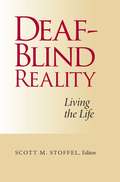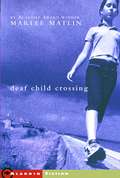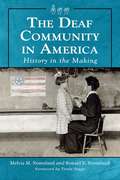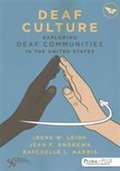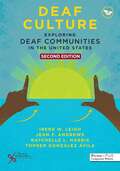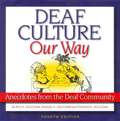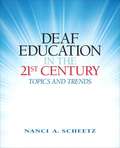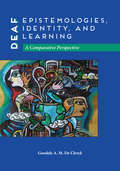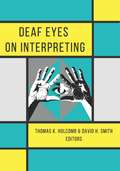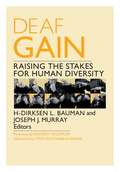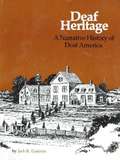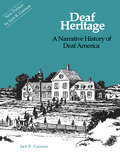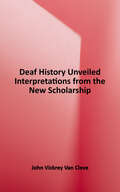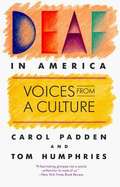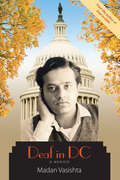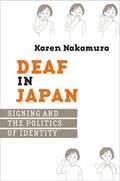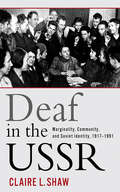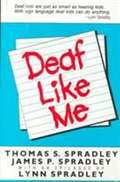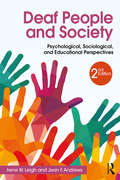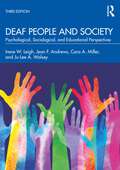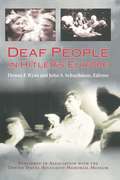- Table View
- List View
Deaf-Blind Interpreting Workbook: Student Readings and Worksheets
by Mary Bauer Karen Chriest Stueland Jackie Engler-Morris Janie Neal Jelica Nuccio Cynthia WallaceThis workbook was put together to cover basic Deaf-Blind interpreting techniques. Over the past years, the Seattle Deaf-Blind Community has shaped this class and the workbook has evolved.
Deaf-Blind Reality: Living the Life
by Scott M. StoffelMost stories about disabled people are written for the sake of being inspirational. These stories tend to focus on some achievement, such as sports or academics, but rarely do they give a true and complete view of the challenges individuals must deal with on a daily basis. For example: How does a deaf-blind person interact with hearing-sighted people at a family reunion? How does she shop for groceries? What goes through his mind when he enters a classroom full of non-handicapped peers? These aren't questions you are likely to find answers to while reading that incredible tale of success. They are, however, issues that a deaf-blind person wishes others understood. Deaf-Blind Reality: Living the Life explores what life is really like for persons with a combination of vision and hearing loss, and in a few cases, other disabilities as well. Editor Scott M. Stoffel presents extensive interviews with 12 deaf-blind individuals, including himself, who live around the world, from Missouri to New Zealand, Louisiana to South Africa, and Ohio to England. These contributors each describe their families' reactions and the support they received; their experiences in school and entering adulthood; and how they coped with degeneration, ineffective treatments, and rehabilitation. Each discusses their personal education related to careers, relationships, and communication, including those with cochlear implants. Deaf-Blind Reality offers genuine understanding of the unspectacular but altogether daunting challenges of daily life for deaf-blind people.
Deaf Child Crossing
by Marlee MatlinA compelling and humorous story of friendship from Academy Award-winning actress Marlee Matlin.Cindy looked straight at Megan. Now she looked a little frustrated. "What's the matter? Are you deaf or something?" she yelled back. Megan screamed out, and then fell to the ground, laughing hysterically. "How did you know that?" she asked as she laughed.Megan is excited when Cindy moves into her neighborhood--maybe she'll finally have a best friend. Sure enough, the two girls quickly become inseparable. Cindy even starts to learn sign language so they can communicate more easily.But when they go away to summer camp together, problems arise. Cindy feels left out because Megan is spending all of her time with Lizzie, another deaf girl; Megan resents that Cindy is always trying to help her, even when she doesn't need help. Before they can mend their differences, both girls have to learn what it means to be a friend.
Deaf Child Crossing
by Marlee Matlin<P>Megan is excited when Cindy moves into her neighborhood -- maybe she'll finally have a best friend. Sure enough, the two girls quickly become inseparable. Cindy even starts to learn sign language so they can communicate more easily. <P> But when they go away to summer camp together, problems arise. Cindy feels left out, because Megan is spending all of her time with Lizzie, another deaf girl; Megan resents that Cindy is always trying to help her, even when she doesn't need help. Before they can mend their differences, both girls have to learn what it means to be a friend. <P> A sensitive depiction of childhood friendship with its fragility, jealousies, and joys" - Booklist
The Deaf Community in America: History in the Making
by Melvia Nomeland Ronald NomelandThe deaf community in the West has endured radical changes in the past centuries. This work of history tracks the changes both in the education of and the social world of deaf people through the years. Topics include attitudes toward the deaf in Europe and America and the evolution of communication and language. Of particular interest is the way in which deafness has been increasingly humanized, rather than medicalized or pathologized, as it was in the past. Successful contributions to the deaf and non-deaf world by deaf individuals are also highlighted. Instructors considering this book for use in a course may request an examination copy here.
Deaf Culture: Exploring Deaf Communities in the United States
by Raychelle L. Harris Irene W. Leigh Jean F. AndrewsHow does Deaf culture fit into education, psychology, cultural studies, technology and the arts? Deaf Culture: Exploring Deaf Communities in the United States addresses this through both theoretical and practical information. With the recognition of American Sign Language (ASL) as a bona fide language, the perception of Deaf people has evolved into the recognition of a vibrant Deaf culture centered around the use of signed languages and communities of Deaf people. This text also describes how rapid advances in technology, including the Internet as well as new visual and auditory technologies, have not only created opportunities for Deaf people to influence how technology can be used, but additionally has become a powerful force in influencing the behavior of Deaf individuals within diverse national and international societies. This has created opportunities for incorporating diversity and international perspectives into Deaf culture. Within each chapter are multiple vignettes, examples, pictures, and stories to enhance content interest for readers and facilitate instructor teaching. Theories are introduced and explained in a practical and reader-friendly manner to ensure understanding, and clear examples are provided to illustrate concepts. In addition, students of American Sign Language and Deaf Studies will find an introduction to possible opportunities for professional and informal involvement with ASL/Deaf culture children and adults. Deaf Culture fills a unique niche as an introductory text that is accessible and straightforward for those beginning their studies of the Deaf-World.
Deaf Culture: Exploring Deaf Communities in the United States
by Irene W. Leigh Jean F. Andrews Raychelle HarrisA contemporary and vibrant Deaf culture is found within Deaf communities, including Deaf Persons of Color and those who are DeafDisabled and DeafBlind. Taking a more people-centered view, the second edition of Deaf Culture: Exploring Deaf Communities in the United States critically examines how Deaf culture fits into education, psychology, cultural studies, technology, and the arts. With the acknowledgment of signed languages all over the world as bona fide languages, the perception of Deaf people has evolved into the recognition and acceptance of a vibrant Deaf culture centered around the use of signed languages and the communities of Deaf peoples. Written by Deaf and hearing authors with extensive teaching experience and immersion in Deaf cultures and signed languages, Deaf Culture fills a niche as an introductory textbook that is more inclusive, accessible, and straightforward for those beginning their studies of the Deaf-World.
Deaf Culture Our Way: Anecdotes from the Deaf Community
by Roy K. Holcomb Samuel K. Holcomb Thomas K. HolcombUsing humorous stories with illustrations, this classic collection brings deaf culture to life through personal experiences and practical day-to-day information. Various aspects of the deaf world are illuminated through anecdotes, updated in this edition to include new stories about the foibles of the latest communication technologies, including VRS, videophones, email, and instant messaging. Also provided is classroom material for teachers that can be used as excellent supplemental reading for deaf studies, ASL, or interpreting classes, as well as a springboard for discussions about deaf culture.
Deaf Culture A to Z
by Walter Paul Kelley"A is for American Sign Language. American Sign Language (ASL) is the language of signs used among many Deaf people. Each sign represents a word or words. In the picture on the right, the boy is signing, "What should I do?" The librarian answers, "You can read a book on Deaf Culture." ASL is a beautiful language and it is fun to learn."
Deaf Education in the 21st Century: Topics and Trends
by Nanci A. ScheetzAs the author writes in his preface to the edition, Deaf education in the 21st century has and will continue to undergo a rapid transformation primarily due to the advent of technological advances, innovative educational opportunities, and shrinking cultural boundaries. This text provides professionals, preservice teachers, interpreters, counselors, and other related personnel with a broad and balanced perspective on current topics and trends germane to the field today. In the coverage of a wide array of topics that include educational perspectives, psychosocial precepts, communication modes, cochlear implants, advances in hearing-aid technology, and other timely and relevant topics, the reader is exposed to a panoramic view of a complex field rather than an in-depth analysis of each of the major dimensions. This text is a sourcebook on the many dimensions found within the field of deaf education. Designed as a teaching-learning vehicle, basic concepts recur in varying situations, and illustrations and some concepts are repeated in diverging contexts to promote comprehension and enhance retention.
Deaf Epistemologies, Identity, and Learning: A Comparative Perspective
by Goedele A. De ClerckGoedele A. M. De Clerck presents cross-cultural comparative research that examines and documents where deaf flourishing occurs and how it can be advanced. She spotlights collective and dynamic resources of knowledge and learning; the coexistence of lived differences; social, linguistic, cultural, and psychological capital; and human potential and creativity. Deaf Epistemologies, Identity, and Learning argues for an inclusive approach to the intrinsic human diversity in society, education, and scholarship, and shows how emotions of hope, frustration, and humiliation contribute to the construction of identity and community. De Clerck also considers global to local dynamics in deaf identity, deaf culture, deaf education, and deaf empowerment. She presents empirical research through case studies of the emancipation processes for deaf people in Flanders (a region of Belgium), the United States (specifically, at Gallaudet University in Washington, DC), and the West African nation of Cameroon. These three settings illuminate different phases of emancipation in different contexts, and the research findings are integrated into a broader literature review and subjected to theoretical reflection. De Clerck’s anthropology of deaf flourishing draws from her critical application of the empowerment paradigm in settings of daily life, research, leadership, and community work, as she explores identity and well-being through an interdisciplinary lens. This work is centered around practices of signed storytelling and posits learning as the primary access and pathway to culture, identity, values, and change. Change driven by the learning process is considered an awakening—and through this awakening, the deaf community can gain hope, empowerment, and full citizenship. In this way, deaf people are allowed to shape their histories, and the result is the elevation of all aspects of deaf lives around the world.
Deaf Eyes on Interpreting
by Thomas K. Holcomb David H. SmithAs the ASL-English interpreting field has become professionalized, there is a growing disconnect between interpreters and the Deaf consumers they serve. Whereas interpreting used to be a community-based practice, the field is growing into a research-based profession that begins in a classroom rather than in the Deaf community. Despite the many gains being made in the interpreting services profession, with an emphasis on the accuracy of the interpreted work, the perspectives of Deaf individuals are rarely documented in the literature. Opportunities for enhanced participation and full inclusion need to be considered in order for Deaf people to best represent themselves to the hearing, nonsigning public as competent and intelligent individuals. Deaf Eyes on Interpreting brings Deaf people to the forefront of the discussions about what constitutes quality interpreting services. The contributors are all Deaf professionals who use interpreters on a regular basis, and their insights and recommendations are based on research as well as on personal experiences. These multiple perspectives reveal strategies to maximize access to interpreted work and hearing environments and to facilitate trust and understanding between interpreters and Deaf consumers. Interpreter educators, interpreting students, professional interpreters, and Deaf individuals will all benefit from the approaches offered in this collection.
Deaf Gain
by Joseph J. Murray H-Dirksen L. BaumanDeaf people are usually regarded by the hearing world as having a lack, as missing a sense. Yet a definition of deaf people based on hearing loss obscures a wealth of ways in which societies have benefited from the significant contributions of deaf people. In this bold intervention into ongoing debates about disability and what it means to be human, experts from a variety of disciplines--neuroscience, linguistics, bioethics, history, cultural studies, education, public policy, art, and architecture--advance the concept of Deaf Gain and challenge assumptions about what is normal.Through their in-depth articulation of Deaf Gain, the editors and authors of this pathbreaking volume approach deafness as a distinct way of being in the world, one which opens up perceptions, perspectives, and insights that are less common to the majority of hearing persons. For example, deaf individuals tend to have unique capabilities in spatial and facial recognition, peripheral processing, and the detection of images. And users of sign language, which neuroscientists have shown to be biologically equivalent to speech, contribute toward a robust range of creative expression and understanding. By framing deafness in terms of its intellectual, creative, and cultural benefits, Deaf Gain recognizes physical and cognitive difference as a vital aspect of human diversity.Contributors: David Armstrong; Benjamin Bahan, Gallaudet U; Hansel Bauman, Gallaudet U; John D. Bonvillian, U of Virginia; Alison Bryan; Teresa Blankmeyer Burke, Gallaudet U; Cindee Calton; Debra Cole; Matthew Dye, U of Illinois at Urbana-Champaign; Steve Emery; Ofelia García, CUNY; Peter C. Hauser, Rochester Institute of Technology; Geo Kartheiser; Caroline Kobek Pezzarossi; Christopher Krentz, U of Virginia; Annelies Kusters; Irene W. Leigh, Gallaudet U; Elizabeth M. Lockwood, U of Arizona; Summer Loeffler; Mara Lúcia Massuti, Instituto Federal de Santa Catarina, Brazil; Donna A. Morere, Gallaudet U; Kati Morton; Ronice Müller de Quadros, U Federal de Santa Catarina, Brazil; Donna Jo Napoli, Swarthmore College; Jennifer Nelson, Gallaudet U; Laura-Ann Petitto, Gallaudet U; Suvi Pylvänen, Kymenlaakso U of Applied Sciences; Antti Raike, Aalto U; Päivi Rainò, U of Applied Sciences Humak; Katherine D. Rogers; Clara Sherley-Appel; Kristin Snoddon, U of Alberta; Karin Strobel, U Federal de Santa Catarina, Brazil; Hilary Sutherland; Rachel Sutton-Spence, U of Bristol, England; James Tabery, U of Utah; Jennifer Grinder Witteborg; Mark Zaurov.
Deaf Heritage: A Narrative History of Deaf America
by Jack GannonThis in-depth history of Deaf America begins with an overview of the early years. Each chapter then covers a decade of history, beginning with 1880. The text is supplemented by marvelous pictures, illustrations, vignettes and biographical profiles. "Subchapters" chronicle the multi-facited dimensions of Deaf culture by focusing on Deaf athletes and more. A complete Deaf Culture course!
Deaf Heritage: A Narrative History of Deaf America
by Jack R. GannonNow, Jack R. Gannon's original groundbreaking volume on Deaf history and culture is available once again. In Deaf Heritage: A Narrative History of Deaf America, Gannon brought together for the first time the story of the Deaf experience in America from a Deaf perspective. Recognizing the need to document the multifaceted history of this unique minority with its distinctive visual culture, he painstakingly gathered as much material as he could on Deaf American life. The result is a 17-chapter montage of artifacts and information that forms an utterly fascinating record from the early nineteenth century to the time of its original publication in 1981.<P><P> Deaf Heritage tracks the development of the Deaf community both chronologically and by significant subjects. The initial chapter treats the critical topics of early attempts at deaf education, the impact of Deaf and Black deaf teachers, the establishment of schools for the deaf, and the founding of Gallaudet College. Individual chapters cover the 1880s through the 1970s, mixing milestones such as the birth of the National Association of the Deaf and the work of important figures, Deaf and hearing, with anecdotes about day-to-day deaf life. Other chapters single out important facets of Deaf culture: American Sign Language, Deaf Sports, Deaf artists, Deaf humor, and Deaf publications. The overall effect of this remarkable record, replete with archival photographs, tables, and lists of Deaf people's accomplishments, reveals the growth of a vibrant legacy singular in American history.<P> Advisory: Bookshare has learned that this book offers only partial accessibility. We have kept it in the collection because it is useful for some of our members. To explore further access options with us, please contact us through the Book Quality link on the right sidebar. Benetech is actively working on projects to improve accessibility issues such as these.
Deaf History Unveiled: Interpretations from the New Scholarship
by John Vickrey Van CleveDeaf History Unveiled features 16 essays, including work of Harlan Lane, Renate Fischer, Margret Winzer, William McCagg, and other noted historians in this field. Readers will discover the new themes driving Deaf history, including a telling comparison of the similar experiences of Deaf people and African Americans, both minorities with identifying characteristics that cannot be hidden to thwart bias. Other studies track societal paternalism toward deaf people in Italy, Hungary, and the United States. Adding to its intrigue, the new research in this milestone study provides evidence for previously uncredited self-determination of Deaf people in establishing education, employment, and social structures common throughout the Northern Hemisphere. Historians, teachers, and students will prize Deaf History Unveiled as a singular collection of insights that will change historical perspectives on the Deaf experience worldwide.
Deaf in America
by Carol Padden Tom HumphriesWritten by authors who are themselves Deaf, this unique book illuminates the life and culture of Deaf people from the inside, through their everyday talk, their shared myths, their art and performances, and the lessons they teach one another. Padden and Humphries employ the capitalized "Deaf" to refer to deaf people who share a natural language--American Sign Language (ASL)--and a complex culture, historically created and actively transmitted across generations. Signed languages have traditionally been considered to be simply sets of gestures rather than natural languages. This mistaken belief, fostered by hearing people's cultural views, has had tragic consequences for the education of deaf children; generations of children have attended schools in which they were forbidden to use a signed language. For Deaf people, as Padden and Humphries make clear, their signed language is life-giving, and is at the center of a rich cultural heritage. The tension between Deaf people's views of themselves and the way the hearing world views them finds its way into their stories, which include tales about their origins and the characteristics they consider necessary for their existence and survival. Deaf in America includes folktales, accounts of old home movies, jokes, reminiscences, and translations of signed poems and modern signed performances. The authors introduce new material that has never before been published and also offer translations that capture as closely as possible the richness of the original material in ASL. Deaf in America will be of great interest to those interested in culture and language as well as to Deaf people and those who work with deaf children and Deaf people.
Deaf in DC: A Memoir
by Madan VasishtaIn his first memoir, Madan Vasishta described being a deaf boy in his homeland India, where "deaf" meant someone who is not human. After rising from herding cattle to being a respected photographer in Delhi, his first memoir concluded with his acceptance at Gallaudet College far away in America. Vasishta's new memoir begins with his arrival in Washington, DC in 1967 with $40.00 in his pocket and very little knowledge of the new worlds he was entering. Vasishta faced myriad challenges from the outset-- he knew no American Sign Language and could not speech read, yet he found himself thrust into classes at Gallaudet two weeks into the semester. Cultural differences mystified him, such as how all American car accidents were someone else's fault even when one's car hits a stationary object. He was amazed that his fellow students did not deride him for his mistakes, unlike in India where he would have been scorned for his weakness. After five years, he returned home to India for a visit and was stunned to learn that he no longer fit in, that "even if you do not have an American Dream, the American Dream will have you." Deaf in DC follows Vasishta through half a century living in America. He witnessed the transformation from facing bias as a deaf, foreign man of color who could not get a job despite having a Ph.D., to receiving five offers as a school superintendent in the wake of the Civil Rights movement and Deaf President Now. His new memoir reflects a genuine worldview informed by the sage perceptions of a person who has lived widely in many worlds.
Deaf in Japan: Signing and the Politics of Identity
by Karen NakamuraUntil the mid-1970s, deaf people in Japan had few legal rights and little social recognition. Legally, they were classified as minors or mentally deficient, unable to obtain driver's licenses or sign contracts and wills.
Deaf in the USSR: Marginality, Community, and Soviet Identity, 1917-1991
by Claire L. ShawIn Deaf in the USSR, Claire L. Shaw asks what it meant to be deaf in a culture that was founded on a radically utopian, socialist view of human perfectibility. Shaw reveals how fundamental contradictions inherent in the Soviet revolutionary project were negotiated—both individually and collectively— by a vibrant and independent community of deaf people who engaged in complex ways with Soviet ideology.Deaf in the USSR engages with a wide range of sources from both deaf and hearing perspectives—archival sources, films and literature, personal memoirs, and journalism—to build a multilayered history of deafness. This book will appeal to scholars of Soviet history and disability studies as well as those in the international deaf community who are interested in their collective heritage. Deaf in the USSR will also enjoy a broad readership among those who are interested in deafness and disability as a key to more inclusive understandings of being human and of language, society, politics, and power.
Deaf Like Me
by Thomas S. Spradley James P. Spradley<P>Deaf Like Me is the moving account of parents coming to terms with their baby girl's profound deafness. The love, hope, and anxieties of all hearing parents of deaf children are expressed here with power and simplicity. <P>In the epilogue, Lynn Spradley as a teenager reflects upon being deaf, her education, her struggle to communicate, and the discovery that she was the focus of her father's and uncle's book. At once moving and inspiring, Deaf Like Me is must reading for every parent, relative, and friend of deaf children everywhere.
The Deaf Musicians
by Pete Seeger Paul Dubois JacobsLee is a piano man. Every night, he plays jazz for the crowd. It sounds something like this:<P><P> Plink-a-plink-BOMP-plink-plink.<P> Yimba-timba-TANG-ZANG-ZANG.<P> One night, Lee's bandmates notice something is off. Lee's music comes out like this:<P> Ronk. Phip. Tonk.<P> There's no way to hide it: Lee is losing his hearing. Then Lee discovers sign language. And soon after, he meets Max, who plays the sax. Together they form a new band-the Deaf Musicians. But who will listen to a deaf musician? <P> With The Deaf Musicians, Pete Seeger, Paul DuBois Jacobs, and three-time Coretta Scott King Honor winner R. Gregory Christie present an inspiring story of overcoming obstacles, set to a jazzy score.<P> OO-AH, BE-DOOP, BE-DOOP, OO-AH, YEAH!<P> Winner of the Schneider Family Book Award
Deaf People and Society: Psychological, Sociological and Educational Perspectives
by Irene W. Leigh Jean F. AndrewsDeaf People and Society incorporates multiple perspectives related to the topics of psychology, education, and sociology, including the viewpoints of deaf adults themselves. In doing so, it considers the implications of what it means to be deaf or hard of hearing and how deaf adults’ lives are impacted by decisions that professionals make, whether in the clinic, the school, or when working with family. This second edition has been thoroughly revised and offers current perspectives on the following topics:<P><P> * Etiologies of deafness and the identification process<P> * The role of auditory access<P> * Cognition, language, communication, and literacy<P> * Bilingual, bilingual/bimodal, and monolingual approaches to language learning<P> * Educational, legal, and placement aspects<P> * Childhood psychological issues<P> * Psychological and sociological viewpoints of deaf adults<P> * The criminal justice system and deaf people<P> * Psychodynamics of interaction between deaf and hearing people<P> Each chapter begins with a set of objectives and concludes with suggested readings for further research. This edition contains 10 new and original case studies, including ones on hearing children of deaf adults, sudden hearing loss, a young deaf adult with mental illness, and more. Written by a seasoned deaf/hearing bilingual team, this unique text continues to be the go-to resource for students and future professionals interested in working with deaf and hard-of-hearing persons.
Deaf People and Society: Psychological, Sociological, and Educational Perspectives
by Irene W. Leigh Jean F. Andrews Cara A. Miller Ju-Lee A. WolseyDeaf People and Society is an authoritative text that emphasizes the complexities of being D/deaf, DeafBlind, Deaf-Disabled, or hard of hearing, drawing on perspectives from psychology, education, and sociology. This book also explores how the lives of these individuals are impacted by decisions made by professionals in clinics, schools, or other settings. This new edition offers insights on areas critical to Deaf Studies and Disability Studies, with particular emphasis on multiculturalism, equity, and inclusion. Accessibly written, the chapters include objectives and suggested further reading that provides valuable leads and context. Additionally, these chapters have been thoroughly revised and incorporate a range of relevant topics including etiologies of deafness; cognition and communication; bilingual, bimodal, and monolingual approaches to language learning; childhood psychological issues; psychological and sociological viewpoints of deaf adults; the criminal justice system and deaf people; psychodynamics of interaction between deaf and hearing people; and future trends. The book also includes case studies covering hearing children of deaf adults, a young deaf adult with mental illness, and more. Written by a seasoned D/deaf/hard of hearing and hearing bilingual team, this unique text continues to be the go-to resource for students and future professionals interested in working with D/deaf, DeafBlind, and hard-of-hearing persons. Its contents will resonate with anyone interested in serving and enhancing their knowledge of their lived experiences of D/deaf, DeafBlind, Deaf-Disabled, and hard-of-hearing people and communities.
Deaf People in Hitler's Europe
by John S. Schuchman Donna F. RyanInspired by the conference "Deaf People in Hitler's Europe, 1933-1945," hosted jointly by Gallaudet University and the United States Holocaust Memorial Museum in 1998, this extraordinary collection, organized into three parts, integrates key presentations and important postconference research. Henry Friedlander begins "Part I: Racial Hygiene" by analyzing the assault on deaf people and people with disabilities as an integral element in the Nazi attempt to implement their theories of racial hygiene. Robert Proctor documents the role of medical professionals in deciding who should be sterilized or forbidden to marry, and whom the Nazi authorities would murder. In an essay written especially for this volume, Patricia Heberer details how Nazi manipulation of eugenics theory and practice facilitated the justification for the murder of those considered socially undesirable. "Part II: The German Experience" commences with Jochen Muhs's interviews of deaf Berliners who lived under Nazi rule, both those who suffered abuse and those who, as members of the Nazi Party, persecuted others, especially deaf Jews. John S. Schuchman describes the remarkable 1932 film Misjudged People, which so successfully portrayed the German deaf community as a vibrant contributor to society that the Nazis banned its showing when they came to power. Horst Biesold's contribution confirms the complicity of teachers who denounced their own students, labeling them hereditarily deaf and thus exposing them to compulsory sterilization. The section also includes the reprint of a chilling 1934 article entitled "The Place of the School for the Deaf in the New Reich," in which author Kurt Lietz rued the expense of educating deaf students, who could not become soldiers or bear "healthy children." In "Part III: The Jewish Deaf Experience," John S. Schuchman discusses the plight of deaf Jews in Hungary. His historical analysis is complemented by a chapter containing excerpts from the testimony of six deaf Jewish survivors who describe their personal ordeals. Peter Black's reflections on the need for more research conclude this vital study of a little-known chapter of the Holocaust.

